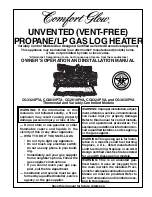
24
4. The ignition of flammable vapors.
A thermopile is used to determine if a pilot flame is
present, and will shut off the gas supply to the main
burner and the pilot if the flame is absent. This unit is
also equipped with a thermal switch, designed to shut off
the gas supply in the event the heater has been exposed
to flammable vapors (spilled gasoline or paint fumes,
for example), poor combustion caused by insufficient
combustion air, or improper venting. If the switch opens,
check the flame arrestor for signs of high temperature
(blue or black discoloration), and inspect your installation
for any problems with venting or combustion air. (See
Pilot Light Troubleshooting Flowchart). Reset the switch
by depressing the small button in the center of the switch.
IMPORTANT:
Correct any issues prior to resetting the
switch. Reference the number on the cover of this manual
for service information.
The gas control valve\thermostat includes a temperature
limiting ECO (Energy Cut Off) system that will shut off
the water heater if the water temperature exceeds 189°F
(87°C) for 155°F models or 199°F (93°C) for 180°F
models. See the data plate for your model.
Should the water temperature get too high, the diagnostic
status light will flash a code (4 flashes), indicating an over-
temperature condition and the main burner will be shut
off. If a high temperature condition occurs, turn the main
gas supply OFF and have the water heater repaired by a
qualified service technician. Contact your local dealer for
service information.
Anode Rod/Water Odor
Each water heater contains at least one anode rod,
which will slowly deplete (due to electrolysis) prolonging
the life of the water heater by protecting the glass-lined
tank from corrosion. Adverse water quality, hotter water
temperatures, high hot water usage, hydronic heating
devices, and water softening methods can increase
the rate of anode rod depletion. Once the anode rod
is depleted, the tank will start to corrode, eventually
developing a leak.
Certain water conditions will cause a reaction between the
anode rod and the water. The most common complaint
associated with the anode rod is a “rotten egg smell”
produced from the presence of hydrogen sulfide gas
dissolved in the water.
IMPORTANT: Do not remove this rod permanently as it will
void any warranties. A special anode rod may be available
if water odor or discoloration occurs.
NOTE: This rod may reduce but not eliminate water odor
problems. The water supply system may require special
filtration equipment from a water conditioning company to
successfully eliminate all water odor problems.
Artificially softened water is exceedingly corrosive because
the process substitutes sodium ions for magnesium and
calcium ions. The use of a water softener may decrease
the life of the water heater tank.
The anode rod should be removed from the water heater
tank every 3 years for inspection.
NOTE: Artificially softened water requires the anode rod to
be inspected annually.
Excessive condensation can cause pilot outage due to
water running down the flue tube onto the main burner and
putting out the pilot.
Because of the suddenness and amount of water,
condensation water may be diagnosed as a “tank leak”.
After the water in the tank warms up (about 1-2 hours), the
condition should disappear.
Do not assume the water heater is leaking until there has
been enough time for the water in the tank to warm up.
An undersized water heater will cause more condensation.
The water heater must be sized properly to meet the
family’s
demands for hot water including dishwashers, washing
machines and shower heads.
Excessive condensation may be noticed during the winter and
early spring months when incoming water temperatures are at
their lowest.
Good venting is essential for a gas fired water heater to operate
properly as well as to carry away products of combustion and
water vapor.
It is always recommended that a suitable metal drain pan
be installed under the water heater to protect the area
from water damage resulting from normal condensation
production, a leaking tank or piping connections. Refer to
the “Location Requirements” section.
Water Heater Sounds
During the normal operation of the water heater, sounds or
noises may be heard. These noises are common and may
result from the following:
1. Normal expansion and contraction of metal parts
during periods of heat-up and cool-down.
2. Condensation causes sizzling and popping within the
burner area and should be considered normal.
3. Sediment buildup in the tank bottom will create varying
amounts of noise and may cause premature tank
failure. Drain and flush the tank as directed under the
“Draining and Flushing” section.
Smoke/Odor
The water heater may give off a small amount of smoke
and odor during the initial start-up of the unit. This is due
to the burning off of oil from metal parts of a new unit and
will disappear after a brief period of operation.
Safety Shut-off
This water heater is designed to automatically shut-off in
the event of the following:
1. The pilot flame is extinguished for any reason.
2. The water temperature exceeds 189°F (87°C) for
155°F models or 199°F (93°C) for 180°F models. See
the data plate for your model.
3. Excessive combustion chamber temperatures.
















































